Big Red Book
Celebrating television's This Is Your Life
Sandy POWELL (1900-1982)
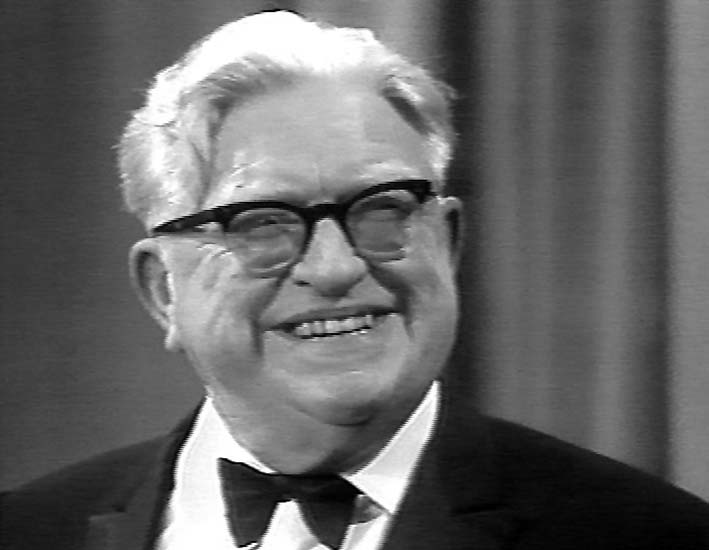
THIS IS YOUR LIFE - Sandy Powell, comedian, was surprised by Eamonn Andrews at Thames Television's Euston Road Studios, having been led to believe he was there to record a sketch as part of a trailer to publicise his forthcoming tour.
Sandy, who was born in Rotherham and first appeared on stage at the age of 7, got his break as a music hall performer in 1915. As a teenage star, he topped the bill at venues all across the UK, and by 1935 he was earning £1000 a week. He appeared in several films during the 1930s, usually as himself, and around the same time, he also began working in radio, introducing his shows with his catchphrase 'Can you hear me, mother?'.
After touring with ENSA during the Second World War, he worked continually on radio and television and in pantomime throughout the 1940s and 1950s. He later developed his own revue show, which he performed on Eastbourne Pier over fifteen seasons in the 1950s and 1960s, earning him the nickname 'Mr Eastbourne'.
"Oh dear, oh dear!"
programme details...
- Edition No: 293
- Subject No: 295
- Broadcast date: Wed 27 Jan 1971
- Broadcast time: 7.00-7.30pm
- Recorded: Wed 25 Nov 1970
- Venue: Euston Road Studios
- Series: 11
- Edition: 11
on the guest list...
- Kay - wife
- Pat Phoenix
- Bert Montague
- Roy Jeffries
- Jimmy Fletcher
- Jessie Matthews
- Bert Murfin
- Evelyn Laye - live link
- Hetty King
- Peter - son
- Peggy Baldwin - daughter
- Brian Baldwin - son-in-law
- Jane Baldwin - granddaughter
- Brian Baldwin Jr - grandson
- Frankie Vaughan
- Wee Georgie Wood not included in broadcast edition:
- Reg Lever
- Norman Meadows
- Arthur Lane
related appearances...
- Evelyn Laye - Aug 1959
- Pat Phoenix - Nov 1972
- Paul Shane - Dec 1981
production team...
- Researchers: Jack Crawshaw, John Stapleton
- Writers: Jack Crawshaw, John Stapleton
- Director: Margery Baker
- Producer: Robert Tyrrell
- names above in bold indicate subjects of This Is Your Life
it's all about the comedy
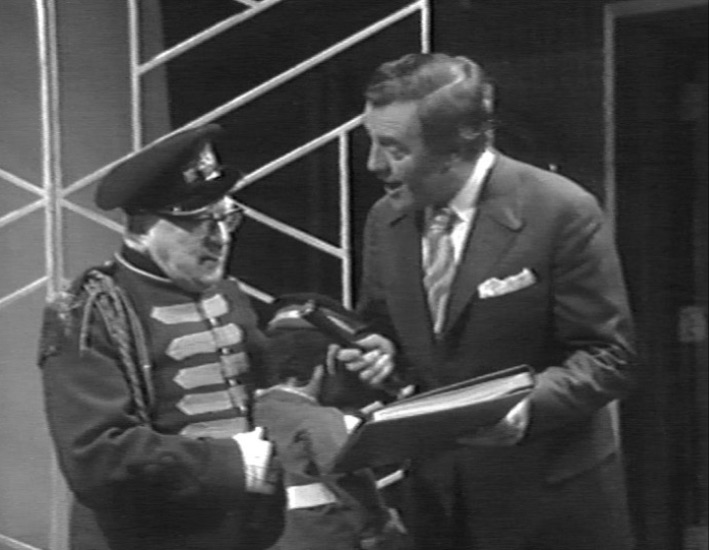
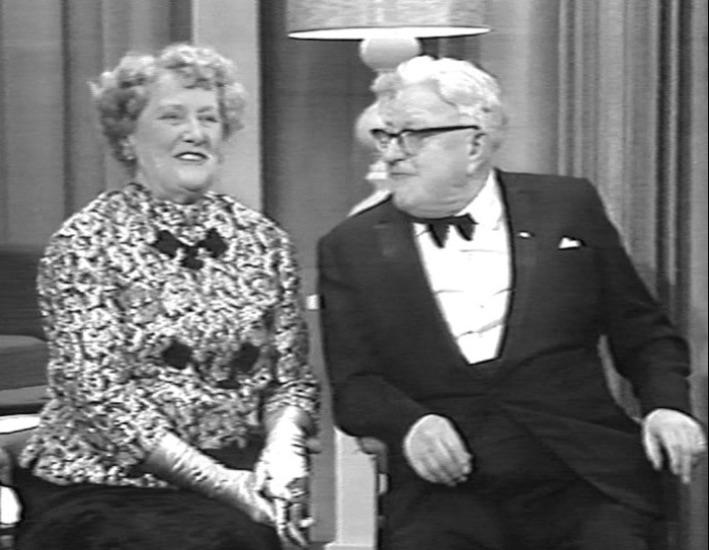
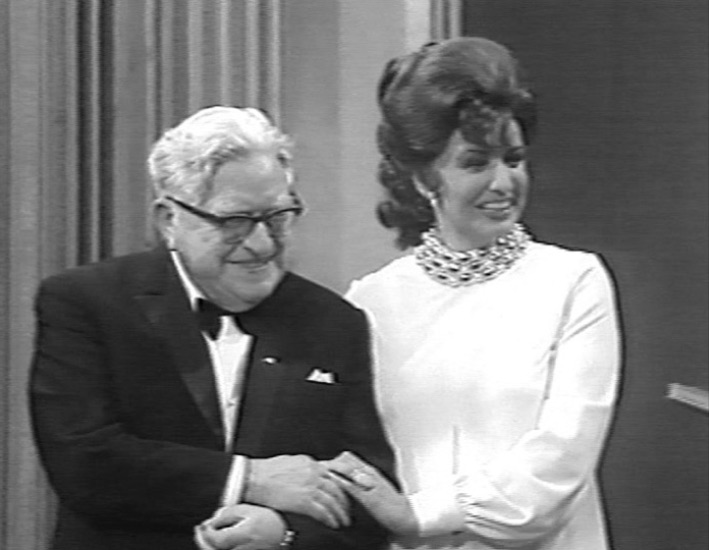
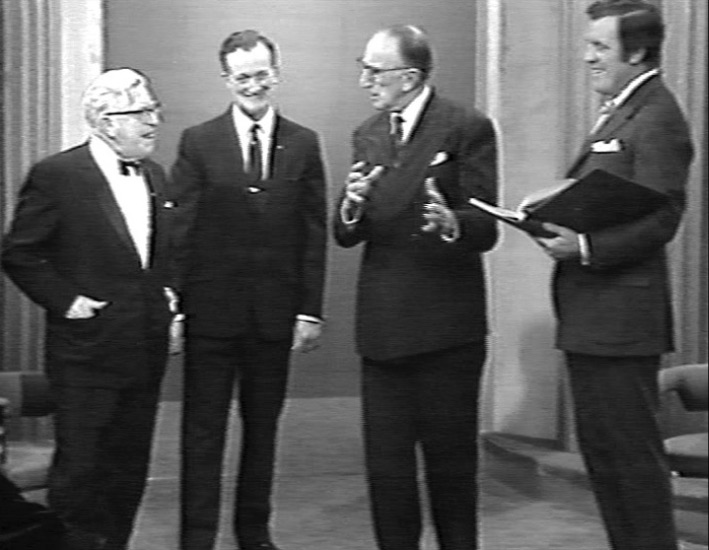
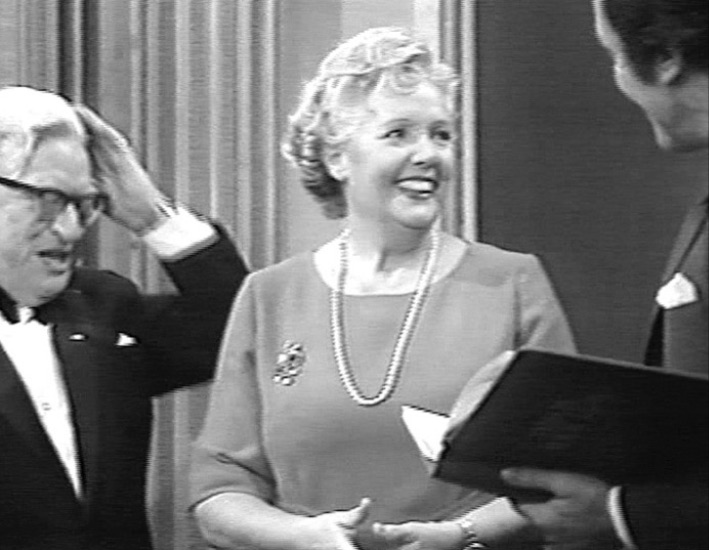
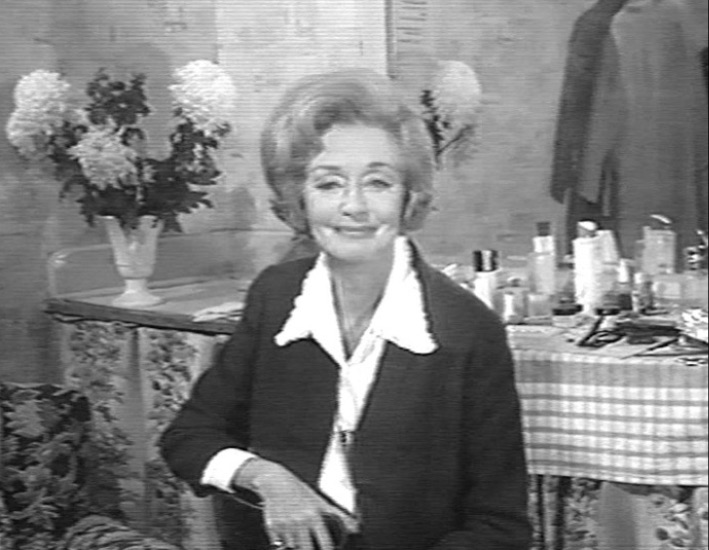
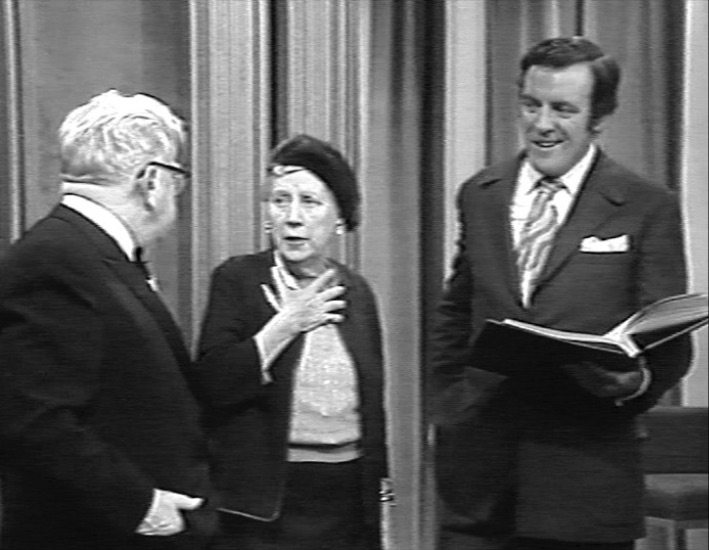
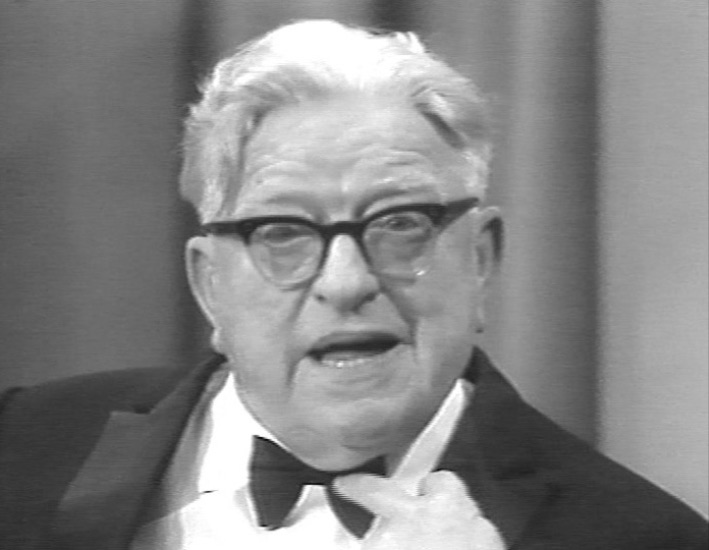
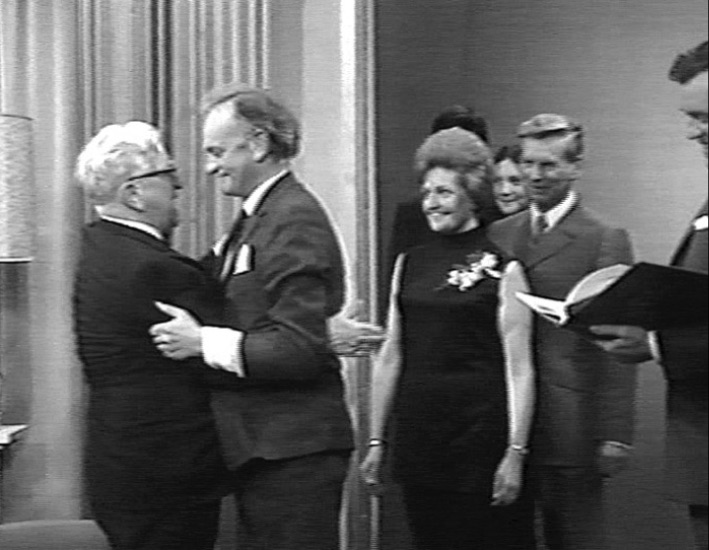
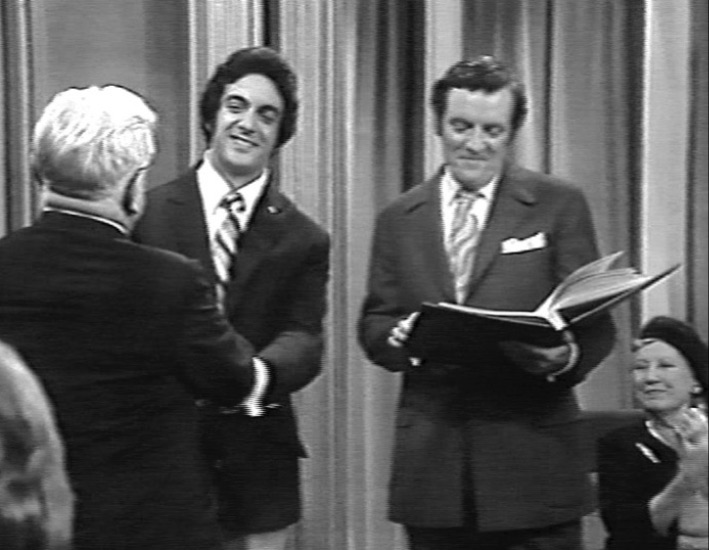
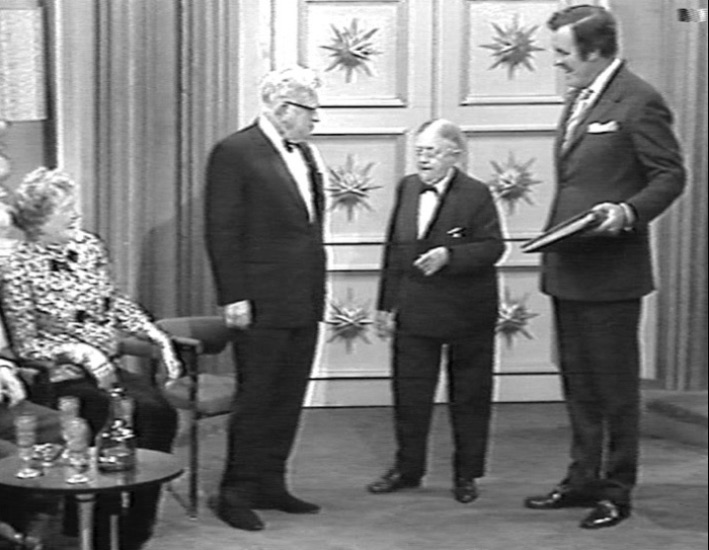
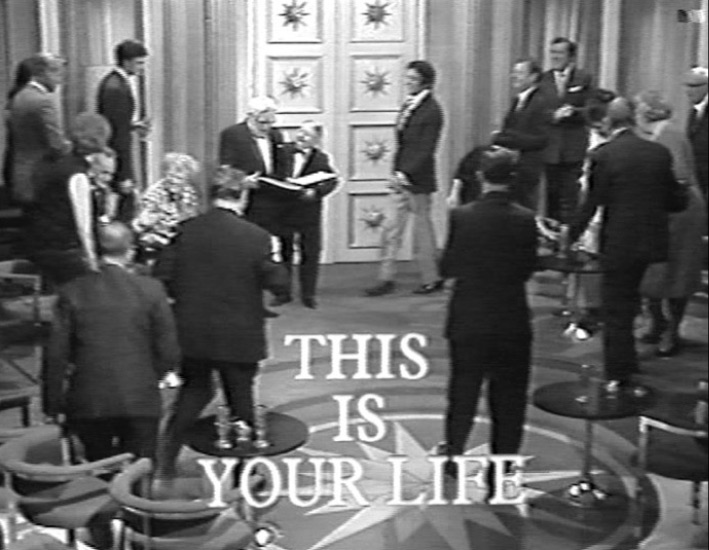
Screenshots of Sandy Powell This Is Your Life
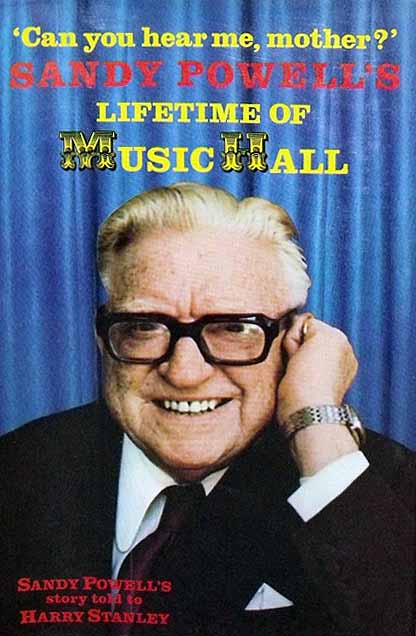
Next followed what was one of the most extraordinary happenings of all during this year. Kay and Sandy were in Betty Jacoby's office talking of how thrilled they were at being selected to appear in the Royal Performance, and the kindness of Jimmy Green giving Sandy such a wonderful 'plug' in the Evening News. As they were leaving, Kay leant across Betty's desk to give her a good-bye kiss, and she felt something being pressed surreptitiously into her hand. Obviously it was meant for her alone, so she waited until an opportunity arose for her to see what it was all about. On a piece of paper was written the message, 'Please ring me.' A few moments before leaving Betty's office an artist had come in to see her and Kay thought that the secrecy was because of this, and that the message was for Sandy, something that Betty could not speak of in the presence of the other artist. Making their way to Sheekeys, the seafood restaurant very popular with show-business people, Kay told Sandy about Betty's note, and while they were there he telephoned Betty, who told him that it wasn't anything special. Sandy, very puzzled, said to Kay: 'I don't know what that was all about, she just told me things we'd already spoken about, she must be getting forgetful.' It then crossed Kay's mind that the message was intended for her, and not Sandy. She thought, 'Oh dear, something's gone wrong about the Royal Show and Betty wants me to break the news gently to Sandy.' At Sheekeys, there was a public telephone downstairs, next to the ladies' room. This provided an excuse for Kay to telephone Betty.
'Why did you get Sandy to phone me, I wanted to talk to you about something we've got to keep very secret. Thames TV want to do a This Is Your Life programme on Sandy, and they want your cooperation.'
Kay said, 'How marvellous! Of course, I'll help.' Little did she know what she had let herself in for. White lies had to be concocted to keep it all from Sandy, life became difficult and very complicated. It was exciting but very nerve-wracking.
Kay knew very little about Sandy's early life, the years before she had met him. There was only two people who knew about his personal life and those were his daughter, Peggy and son, Peter. Jack Crawshaw was in charge of operations at Thames TV, and it was a devious business establishing contact without Sandy knowing. That was the first problem to be solved. Obviously a regular line of communication had to be set up. The telephone at home could not be used because she and Sandy were always together. Kay then remembered their friend Norman Meadows who was now manager of the pier, just around the corner. He was a constant and regular caller at the house and therefore a perfect message-carrier and contact man. Thames could telephone him and their message could be conveyed to Kay during his regular, almost daily visits to their house. Norman remembers, with amusement how Kay first approached him about the matter. Through his secretary she sent a message that she wanted to see him urgently, and in private.
When she came to his office her manner was almost furtive and he wondered whether there was some serious personal trouble. This was soon dispelled when she said 'Norman, Thames want to have Sandy on This Is Your Life, and we have got to get a place where we can have messages taken and organised generally. Can it be done here?' Norman, thrilled by the honour being paid to his great friend, readily gave his assent and promise of full cooperation. Pier director Alf Lake agreed to his office being used as the 'secret operations centre'. Jack Crawshaw was notified immediately, Kay put him in the picture, explaining her difficulties, which could only be solved by getting the help of their friend and partner Norman Meadows to set up lines of communication between herself and London. She also mentioned Peggy as the only means of finding out about Sandy's early life, and Bert Montague, the first man that gave him a big break. She wanted his permission to approach them. 'That would be great,' he said, 'but, please do emphasise the necessity for absolute secrecy. Not the slightest hint must be given to anyone.'
Clandestine telephone calls to Peggy and Bert Montague were made and their participation was sought and delightedly agreed to, and the snowball started to roll. A tricky preliminary was the problem of excuses for Kay to get out of the house on her own, without rousing suspicion. Kay had to use all her natural feminine intuition to make up a battery of excuses, and she knew that she couldn't overdo it. Norman who normally dropped in for 'elevenses' gave Kay the 'wink' when she was needed to go to the office to do a bit of phoning. As time went by things became more devious and complicated; Kay was almost running out of excuses. How it was all done without Sandy finding out, will for ever remain a mystery as far as Kay is concerned. So much had to be done, gathering up programmes, photographs and posters for Thames to enlarge for projection on to the big screen in the TV studio. Tracing the people connected with Sandy's past, his helpers and colleagues was a mammoth task. In this respect the Thames research team worked wonders. Nothing was too much trouble for them. Kay would say, 'I know there was a young boy named Jimmy Fletcher who sang in Sandy's Road Show in the thirties. I believe he lived somewhere near Sheffield.'
'Leave that to us,' they replied, and trace him they did, much to Sandy's delight when he saw him on the show eventually, after so many years. The same thing happened with Roy Jeffries, who Kay remembered had once been mentioned by Sandy, who described him as a 'great feed' and character actor he had with him in his shows and films. 'Where does he live?' Kay was asked.
'Somewhere near Coventry, I believe,' was her reply. It was as vague as that, but they found him. It is doubtful whether the millions who view this popular programme have any idea of the enormous amount of work that goes into its preparation. The skill and patience of the organising and research staff is almost limitless.
The final problem was the toughest of all to solve – the pretext to get him to the studio without arousing his suspicion. Arthur Lane came up with a brilliant idea. He told Thames that Sandy was going to South Africa with his Golden Years show. 'I can tell Sandy that I have been requested by the management there to make a short filmed interview and an excerpt of one of Sandy's routines for them to use as a trailer-advertisement to publicise the forthcoming tour.' Thames was thrilled with the idea and promised their utmost cooperation. Arthur told Sandy about the proposed film and said he would prepare a script for him to learn. Kay said that when Arthur gave him the script he took it all very seriously and sat up studying it thoroughly until he had got it all off 'pat'. Arthur, a first-class producer in his own right went to London to view the studio set-up to make sure that his idea was properly used. The Thames TV building in Euston Road, London, was next door to the Rank building, and the name 'Rank' in neon-lights was displayed at the top of the building, so Arthur suggested that the dummy cameras used in the supposed film studio should each have the name 'Rank Films' inscribed on a plate fixed to the camera to replace the 'Thames TV' already on them. The proposed entrance to be used was to be sign-posted with the name 'Rank Films', as were all the notices and plates of the rooms in the corridor leading to the studio, which included the name of Eamonn Andrews, whose office was in that particular corridor. A great deal of trouble was taken to ensure that everything that might look suspicious was removed and replaced by things more appropriate.
Another complication arose when Kay and Norman were asked to attend the rehearsal on the day before the show. By sheer coincidence it was the day that Sandy had to go to London to do the commentary on the documentary film being made by the BBC about Fred Karno's disastrous venture at Taggs Island. Kay said that if it hadn't been for that, she would not have known what excuse to use to cover her journey to London. But there was another hurdle to cross in respect to Sandy's 'Karno trip'. Kay always accompanies Sandy. Wherever he goes, whatever he does, Sandy likes her by his side. There is a wonderful rapport between them. 'How on earth am I going to get out of this?' she wondered. She left it until the very morning of departure and said to Sandy, 'I will go to town with you with the greatest pleasure, but I don't know the first thing about Fred Karno and I won't be able to help you in any way.'
Sandy replied, 'That's all right, love, it's a lousy day, you'll get cold hanging around in the open at Taggs Island doing nothing. Come down on a later train, let's meet at Sheekeys this evening, say around seven, we'll have dinner and perhaps see a show.' A taxi was ordered to get them to Eastbourne station in good time to catch the early train to London, but Sandy went off on his own. Kay hurriedly got in touch with Norman Meadows and arranged for him to pick her up at the house to catch a later train together. It was only later they realised that it could have all been easily misunderstood by the neighbours!
Norman had actually been in London the previous day for a rehearsal, and had caught the last train back to Eastbourne. Kay was wanted at the final rehearsal, to see where she was to sit during the show and to run through her lines about her life with Sandy. As arranged, she met Sandy who told her what had happened that day at Taggs Island, and they had a very happy evening and stayed in London for the night. At the appointed time on the next day, 25th November 1970, Arthur Lane arrived in a chauffeur-driven car, supplied by the studio to take them to Euston Road. He brought with him a large suitcase in which were packed Sandy's working clothes and props. Also included, and unbeknown to Sandy, was a dinner jacket, shirt and shoes into which he was to quickly change immediately after being 'discovered filming', by Eamonn Andrews. It had to be a very quick change as it was only a short walk to the hall where the invited studio audience was waiting to greet him. A little way off from the studio Arthur suggested that they stop at a pub for a drink before they went to the studio. 'Good idea,' said Sandy and they found a nice place. Sandy went to the bar to get the drinks and Arthur said to Kay, 'Before we leave here, make sure that Sandy goes to the men's room. If he doesn't, it will just be our luck if he wants to go when we are there, and he will bash into Eamonn Andrews. Just before we leave here, I will say to Sandy: "Why not go to the men's here?" and you back me up.' This request puzzled Sandy, but he did what he was asked, but when they were walking to the car, he remarked quietly to Kay, 'Why was Arthur anxious I went to the men's before we get to the studio?'
'You know Arthur' replied Kay. 'You know how cautious he is. We are on a tight schedule, they may want you to get on with the filming as soon as we get there, it's the sensible thing to do really.' When they arrived at the entrance to the building, the notice on the door reading 'Rank Film Studio', gave Sandy no clue that things were different to what they were supposed to be. The commissionaire whispered to Kay, 'Hold it a couple of minutes, while they get Mr Andrews and his staff out of the way.' Kay responded by keeping Sandy busy until she got the all-clear sign from the doorman. As soon as they got to their dressing-room and deposited their cases, Sandy wanted to go out and have a look round. Kay had to make all sorts of excuses to persuade him to stay put. 'They might call us any minute, let us dress first and have a look round later.' They were tense nerve-wracking minutes. If Sandy had seen anything of the cast of the evening's 'main event', it would have ruined everything.
Sandy, dressed in his officer's uniform, and Kay, dressed in the clothes she wore in the act, were eventually called to the studio where the film was being shot. The technicians and lighting men went about their work as they normally would, as did the men on the cameras who measured the distances for correct focussing – all the things necessary in the way of preliminaries before the actual filming. They performed their various tasks and went through the motions so seriously that there wasn't a chance for Sandy to realise it was all false. Later when all was revealed, Sandy said, 'I wish I had those men on contract, what a bunch of actors!'
Arthur directed operations, first running through the short interview and then Sandy's act up to the point where Kay made an entrance to say accusingly to Sandy, 'I saw your lips moving.' This was the arranged cue for Eamonn to enter and start the ball rolling. But nothing happened, Eamonn wasn't there. Arthur thinking quickly said, 'Let us try it again.' They did, but the same thing happened, Eamonn did not enter. 'Let's do it just once more,' said Arthur. Sandy whispered to Kay, 'What's the matter with Arthur? I've done this sketch for over twenty-five years, doesn't he think I know the ruddy thing by now.' Realising that Sandy was getting a bit jumpy and about to ask for another repeat, Arthur caught the signal that Eamonn was standing by and said, 'Let's just have it from your line, Kay,' and when she said, 'I saw your lips moving', Eamonn came into sight and said, 'Sandy, I also saw your lips moving.' Before he could say another word Sandy exclaimed, 'Eamonn Andrews! How nice to see you, do you realise that we have both been in the business for years yet this is the first time we've ever met.' He didn't realise what was happening until Eamonn showed him the book and said 'Sandy Powell, this is your life.' Even at this moment Sandy couldn't grasp it and he was still in a daze when Kay led him away to change into a dinner jacket.
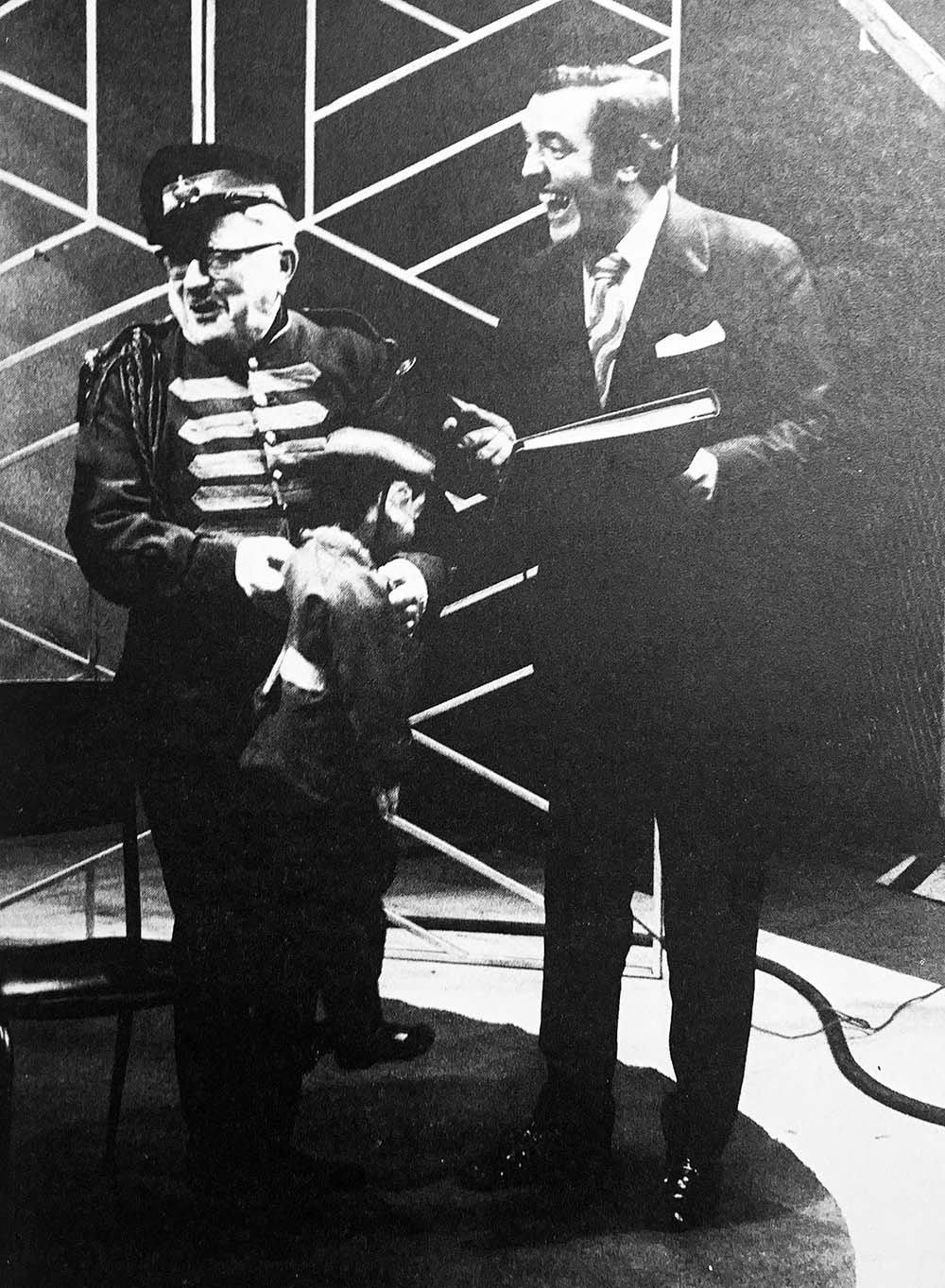
Only a couple of minutes after this shock, a packed and very enthusiastic audience greeted him on an occasion when he was to have his past life unfolded before him and millions of viewers. He was to meet once again colleagues he hadn't seen for years who had come long distances to pay tribute to him. Eamonn in his own inimitable way started with the words, 'Well Sandy that sketch of yours I interrupted is one of the many you have used in your career that spans sixty-five years of success; films, records, stage, radio and television.' Eamonn then introduced a succession of people who had come into his life: his dear wife Kay, then his daughter Peggy, son Peter, son-in-law Brian and his grandchildren. Also there were a young lady called Pat Pilkington who was now famous as Pat Phoenix (Elsie Tanner), star of Coronation Street, Bert Montague, the man who gave him his first big break, Roy Jeffries, a super 'feed', and boy soprano Jimmy Fletcher who both assisted Sandy in the 1935 Royal Show. Jessie Matthews, who also appeared on that same programme, Bert Murfin, who for over twenty years had been Sandy's stage manager and general factotum attended, as did Evelyn Laye, a great theatrical personality with whom he had often worked in many presentations. This was followed by the presence of a lady whom Sandy considers the finest artist he ever worked with, Hetty King, who at the age of eighty-six was still working. Then a star of international fame and fellow Water Rat, Frankie Vaughan, who had flown over from America especially to be on the programme said: 'Because of the great respect we have for Sandy in the business, and because he epitomises all the good things that we hope to become, a man all the comics laugh at, and all the boys in the business love, but, most of all the man we aspire to be, a man with great respect and a great pro.' This was a wonderful tribute from a fellow star to someone greatly beloved by every member of the profession. Finally, there appeared someone who was himself a national institution of show business, and who had in 1915 booked Sandy to deputise for him, when he was known as 'Wee Georgie Wood'. The memorable session ended with Eamonn handing over the book and saying the magic words, 'Sandy Powell, this is your life.'
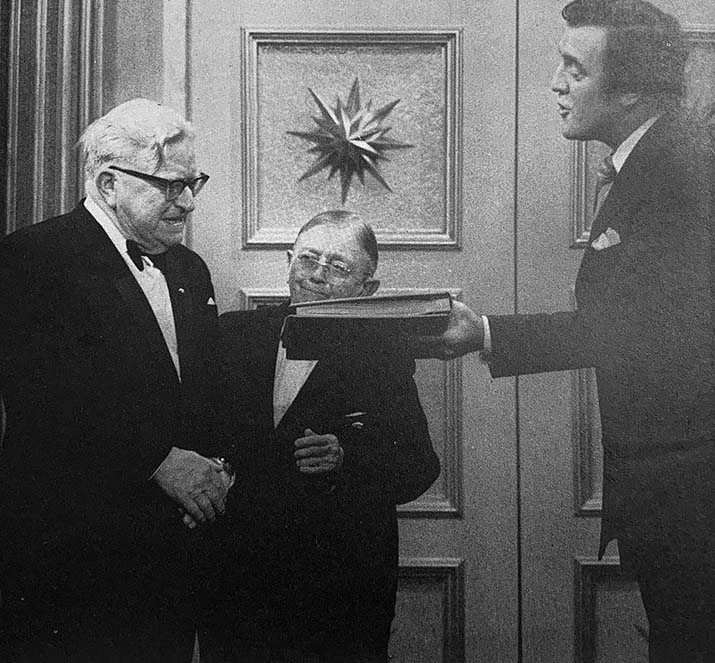
Most viewers believe that the recipient takes away this volume to cherish as a memory of a wonderful occasion. This is not so. The volume used by Eamonn, which viewers see on the screen, is a 'dummy book', in which are written the notes and cues to guide him through the programme he handles so expertly. Around three weeks later the postman brought Sandy a parcel containing a handsome red leather-bound volume. Engraved in gold on the front cover are the words: 'This Is Your Life Sandy Powell.' The first inside page is also engraved in gold letters with the words, 'This book is presented to Sandy Powell as a memento of his appearance as the subject of This Is Your Life.' This is followed with a hand-written message: 'All of us were honoured to have had the chance to pay our small tribute to a great laughter-maker. Eamonn Andrews.' The other pages are filled with photographs both in colour and black and white, of all those that took part in the programme, with appropriately worded captions on each. Attached to the inside back cover is a pocket containing a double-sided gramophone record, a complete transcription of every word spoken in the memorable programme. It is a volume that Sandy will cherish for the rest of his life. His one regret is that, deleted from the screen show, perhaps because of lack of time, were the two men who did so much towards its making, Norman Meadows and Arthur Lane, without whose help things may have not run so smoothly nor turned out so successfully.
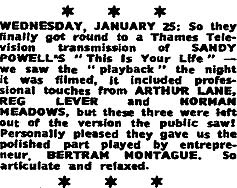
The Stage 11 February 1971
WEDNESDAY, JANUARY 25: So they finally got round to a Thames Television transmission of SANDY POWELL'S This Is Your Life – we saw the "playback" the night it was filmed, it included professional touches from ARTHUR LANE, REG LEVER and NORMAN MEADOWS, but these three were left out of the version the public saw!
Personally pleased they gave us the polished part played by entrepreneur, BERTRAM MONTAGUE. So articulate and relaxed.
Series 11 subjects
Bob Hope | Vidal Sassoon | Talbot Rothwell | Mike and Bernie Winters | Joe Brown | Patrick Campbell | Bobby MooreRobert Soutter | Graham Hill | Sandy Powell | Edward Woodward | Moira Lister | Dickie Henderson | Wilfred Pickles
Kenny Ball | Marjorie Proops | Basil D'Oliveira | Clive Dunn | Peter Noone | Monica Dickens | Jon Pertwee
Lionel Jeffries | Adam Faith | Googie Withers | Matt Busby